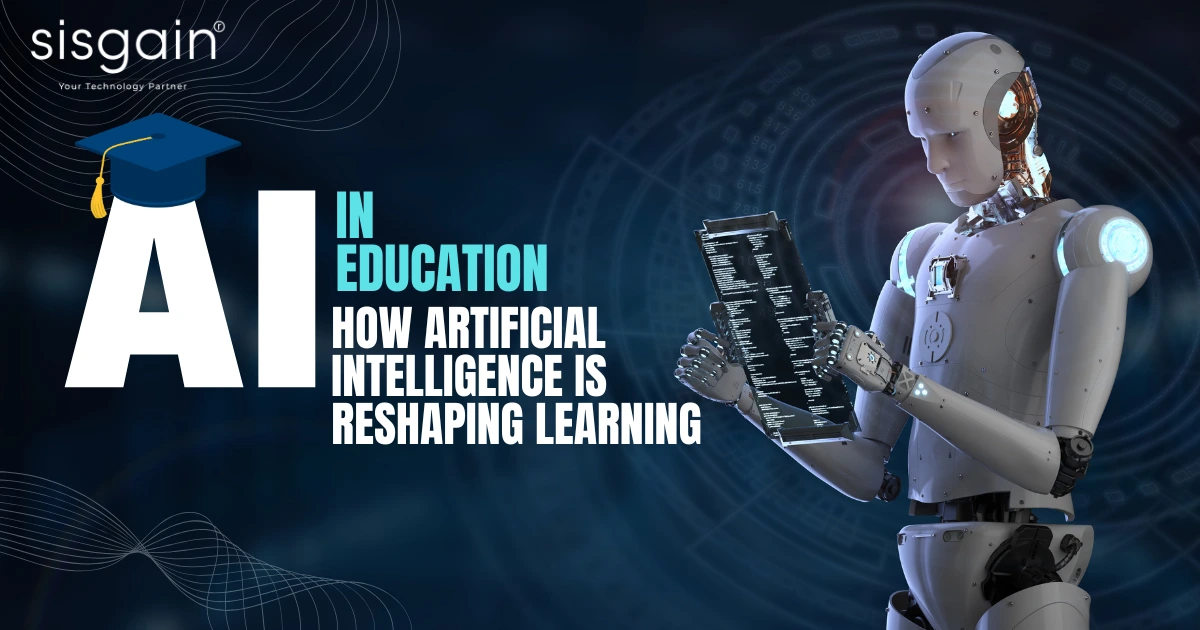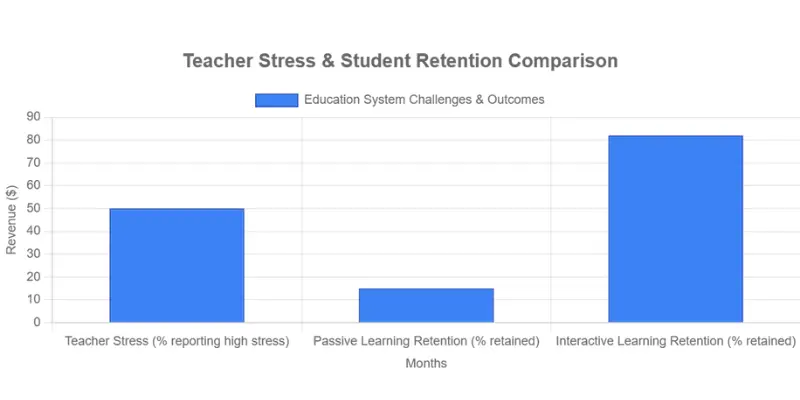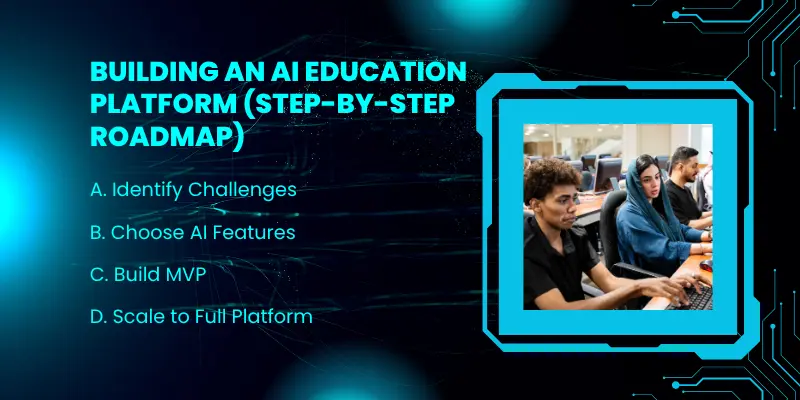Sales Team
Project quotes, partnerships, implementation

In an era where digital transformation is no longer optional, the integration of AI in education stands as a pivotal force driving innovation and equity in learning. As classrooms evolve from chalkboards to cloud-based platforms, artificial intelligence in education emerges not just as a tool, but as a catalyst for reimagining how knowledge is delivered, absorbed, and applied. This blog explores the role of AI in education, from its foundational concepts to cutting-edge applications, backed by real-world examples and forward-looking insights.
The global shift toward digital learning has accelerated dramatically, especially post-pandemic, with educators and institutions worldwide embracing technology to bridge gaps in access and personalization. Today, AI for education is at the forefront of this revolution, enabling smarter, more responsive learning environments that adapt to individual needs rather than adhering to rigid structures.
A striking statistic underscores this momentum: In 2025, 86% of education organizations report using AI in some capacity, reflecting widespread adoption across K-12, higher education, and professional training sectors. This surge is fueled by the global AI in education market, which reached $7.57 billion in 2025, marking a 46% increase from the previous year.
At its core, this blog's thesis is clear: AI is moving from supporting education to transforming it entirely. By harnessing data-driven insights, automation, and adaptive algorithms, artificial intelligence in education promises to democratize learning, reduce inequities, and prepare students for a future where AI is ubiquitous. Whether you're an educator, parent, or edtech enthusiast, understanding the role of AI in education is essential to navigating this new landscape.
At its simplest, AI in education refers to the use of artificial intelligence technologies—like machine learning, natural language processing, and predictive analytics—to enhance teaching, learning, and administrative processes. Think of it as a smart assistant that observes, learns, and responds in real-time, much like a human tutor but scaled infinitely.
In non-technical terms, AI for education isn't about robots replacing teachers; it's about empowering them. For instance, AI can analyze a student's quiz responses to suggest tailored study materials, or use voice recognition to provide instant pronunciation feedback in language classes. Today, AI appears in education through everyday tools: automated grading systems that score essays with nuanced feedback, adaptive tests that adjust difficulty on the fly (like those in platforms similar to Coursera), and personalized content recommendations that curate reading lists based on a learner's pace and interests.
This modern context is rooted in edtech's explosive growth, where personalized learning has become the gold standard. As one example, consider how AI-driven platforms rewrite the script on student engagement—gone are the days of static lectures; enter dynamic, interactive experiences that evolve with the user.
If you're exploring options to integrate such innovations, partnering with reliable artificial intelligence service providers can streamline the process, ensuring seamless implementation tailored to your institution's needs.

Traditional learning models, while foundational, are increasingly strained under modern demands. The one-size-fits-all curriculum forces diverse learners into uniform molds, leaving high-achievers unchallenged and struggling students overwhelmed. This rigidity exacerbates achievement gaps, particularly in underserved regions where resources are scarce.
Compounding this is teacher workload and burnout—a global crisis where educators juggle lesson planning, grading, and administrative tasks, often leading to diminished focus on mentorship. Surveys indicate that over 50% of teachers report high stress levels due to these burdens, diverting energy from what matters most: inspiring curiosity.
Student engagement also suffers in conventional classrooms, where passive absorption replaces active participation. Studies show that disengaged learners retain only 10-20% of material, compared to 75-90% in interactive settings. Moreover, limited data-driven insights mean educators often react to problems rather than prevent them, missing opportunities for early intervention.
Enter AI in education: By addressing these pain points head-on, artificial intelligence offers scalable solutions that human efforts alone can't match. It's not just about efficiency; it's about equity, ensuring every student—regardless of background—has access to high-quality, customized education.
The role of AI in education is multifaceted, acting as an invisible architect that personalizes, predicts, and automates the learning journey. Below, we break it down into key impacts, illustrated with real-world parallels to platforms like interactive learning apps.
AI-powered adaptive learning engines create personalized learning paths for each student, adjusting content difficulty and pace in real-time. For example, if a learner excels in algebra but falters in geometry, the system prioritizes targeted exercises, boosting mastery rates by up to 30%—much like how global edtech leaders refine user experiences through continuous data feedback.
Through machine learning, AI detects learning gaps early by analyzing patterns in performance data. This foresight allows for proactive interventions, such as recommending supplemental resources before a student falls behind, transforming potential dropouts into confident achievers.
AI handles repetitive tasks like grading multiple-choice quizzes or scheduling reminders, significantly reducing instructor workload. Educators freed from these chores can invest in creative teaching, fostering deeper connections and innovation in the classroom.
Advanced analytics from AI tools help improve curricula by aggregating anonymized data across cohorts. Institutions gain actionable insights—e.g., which topics spark engagement—enabling data-backed refinements that elevate overall educational quality.
These roles aren't theoretical; they're powering the next wave of edtech, where AI for education seamlessly blends with human expertise.
The infusion of AI in education yields tangible, transformative benefits that ripple through student performance, teacher efficacy, and institutional scalability.
First, faster learning: Adaptive algorithms compress timelines, with studies showing AI-assisted students completing courses 40% quicker than traditional methods. This acceleration isn't superficial—it's rooted in optimized retention through spaced repetition and micro-assessments.
Second, higher engagement: Gamified AI elements, like progress badges and interactive simulations, captivate learners. Engagement metrics from edtech platforms reveal a 25-50% uplift in session times, turning "duty" into delight.
Third, inclusivity: For students with disabilities, AI shines through tools like text-to-speech converters or sign language interpreters, ensuring accessibility. This levels the playing field, with inclusive AI fostering environments where neurodiverse learners thrive.
Finally, real-time feedback loops: Instant, constructive critiques—far beyond "correct/incorrect"—empower iterative improvement. Research highlights that such loops enhance critical thinking by 35%, as students actively refine their approaches.
To harness these advantages, consider investing in robust education software development and e-learning software solutions that embed AI natively, customizing outcomes for your unique ecosystem.
Diving deeper than surface-level lists, here are 15 innovative use cases of AI in education, each expanded with unique angles on implementation, impact, and scalability. These draw from global deployments, offering actionable inspiration.

Adaptive learning systems powered by AI go far beyond the traditional "correct or incorrect" quiz approach. These systems use reinforcement learning algorithms to continuously refine what a student learns next, based on their knowledge level, pace of learning, and emotional state. Instead of simply predicting test scores, AI analyses behavioral patterns—like hesitation time, preferred content type (video vs. text), and accuracy trends—to predict motivation and engagement levels. The system then modifies the curriculum: simplifying lessons when frustration is detected or increasing complexity when mastery is evident. This is especially impactful in hybrid and remote classrooms, where teachers cannot constantly track all learners individually. Schools adopting adaptive learning tools report improved retention rates, reduced learning gaps, and better student satisfaction. It adds an individualized tutor-like layer to every lesson—scaling personalization across thousands of students.
AI-powered smart content creation uses Natural Language Processing (NLP) to convert large educational content into easily consumable micro-modules. It analyzes student queries, identifies gaps, and instantly generates personalized study material—whether short articles, infographics, flashcards, or even AI-generated explainer videos. Microlearning is proven to increase information retention and reduce mental fatigue, especially among young or busy learners. Instead of a teacher spending hours preparing resources, AI can automatically summarize textbooks and lecture notes into concise chunks, reducing content creation time by nearly 70%. The biggest advantage is agility: learners receive content right when they need it, not days later. For educators and institutions, smart content tools ensure scalability and consistency across multiple subjects and batches.
AI-based automated grading systems combine machine vision and pattern recognition to analyze handwritten and typed assignments. Instead of only checking final answers, AI evaluates the entire reasoning process, ensuring fairness and consistency—something manual grading often lacks due to human biases or fatigue. With accuracy levels reaching 95% in STEM subjects, AI grading frees teachers from hours of repetitive evaluation work. Teachers get dashboards showing strengths and weaknesses across the class, while students receive instant results and actionable insights. The biggest benefit is speed—grading that would take days is completed within minutes—allowing educators to invest more time in instruction, student guidance, and strategic classroom planning.
Essay evaluation powered by generative AI models assesses essays for clarity, grammar, argument structure, originality, and tone. Instead of simply flagging mistakes, AI offers human-like improvement suggestions, similar to a writing mentor or peer reviewer. What makes this revolutionary is scale—thousands of essays can be evaluated simultaneously without compromising quality. AI tools also check for plagiarism, relevance to the topic, coherence between paragraphs, and overall readability. Students receive instant feedback and revision tips, reducing the dependency on teachers for every draft. For education institutions, this leads to improved writing skills across the board and standardized evaluation. AI essay tools are now being used to help students learn the “why” behind corrections, not just highlight errors.
AI learning chatbots provide individualized feedback based on student performance, instantly after assignment submissions. These systems use sentiment analysis to detect emotions behind student questions—frustration, confusion, or curiosity—and respond accordingly. This encourages a growth mindset, a critical element in modern pedagogy. Instead of generic messages like “try again,” the AI chatbot explains mistakes, recommends learning resources, and gives step-by-step guidance. Students interact with the chatbot the same way they would with a tutor, asking follow-up questions anytime. Schools implementing these tools report higher student engagement, reduced anxiety around assignments, and better academic independence.
Intelligent Tutoring Systems are like virtual one-on-one mentors that mimic the Socratic teaching method, asking guiding questions instead of giving direct answers. These systems analyze how each student thinks and adapts their teaching style accordingly—breaking down history narratives, explaining scientific concepts, or solving mathematical equations. What makes ITS powerful is its ability to adapt to cognitive styles, helping students who struggle with traditional teaching methods. Research shows these systems boost learning retention by up to 50% because learners stay engaged and motivated throughout the learning journey. ITS ensures every student receives personalized attention—something impossible in crowded classrooms.
Artificial Intelligence has transformed learning accessibility for differently-abled students. Haptic feedback devices combined with AI can translate braille text to audio in real time, empowering visually impaired students to interact with digital content independently. AI speech recognition assists students with motor impairments through voice commands and hands-free navigation. Predictive behavior analysis supports neurodivergent learners by suggesting better learning pathways and reducing classroom anxiety. Schools using these technologies are moving toward inclusive learning environments where every student can learn at their own pace without feeling dependent on others. AI ensures education is not just digital—but truly accessible.
AI-powered exam monitoring uses behavioral tracking and blockchain for secure data trails, ensuring that no digital manipulation or intervention occurs during assessments. These systems analyze eye movement, sound patterns, screen activity, and sudden behavioral changes. If unusual patterns appear—like switching windows rapidly or suspicious head movements—the platform flags the activity. The blockchain layer ensures that exam data cannot be modified or tampered with. Unlike traditional monitoring methods, this system protects integrity without invading student privacy thrAI-powered exam monitoring uses behavioral tracking and blockchain for secure data trails, ensuring that no digital manipulation or intervention occurs during assessments. These systems analyze eye movement, sound patterns, screen activity, and sudden behavioral changes. If unusual patterns appear—like switching windows rapidly or suspicious head movements—the platform flags the activity. The blockchain layer ensures that exam data cannot be modified or tampered with. Unlike traditional monitoring methods, this system protects integrity without invading student privacy through constant manual surveillance. Institutions adopting this report a significant reduction in academic malpractice during online examinations.ough constant manual surveillance. Institutions adopting this report a significant reduction in academic malpractice during online examinations.
Virtual AI assistants act as 24/7 on-platform support guides, answering queries instantly—reducing student dependency on instructors. They integrate with LMS (Learning Management Systems) and automatically fetch relevant resources, track deadlines, recommend study material, and even remind learners of upcoming assignments. Students no longer waste time navigating complex platforms; instead, they rely on conversational interactions:
"Show me my upcoming deadlines" → AI fetches them instantly.
These AI assistants improve course completion rates and enhance learner satisfaction—especially for remote and self-paced e-learning environments.
Voice-based AI interfaces are a breakthrough for students with mobility challenges, writing difficulties, or motor impairments. Using speech-to-text and text-to-speech, students can:
AI models recognize accents, dialects, and speech speed, ensuring accurate interaction across cultural and linguistic variations. For differently-abled students, this technology removes barriers and gives them equal access to education via mobile devices and smart classrooms.
AI curriculum mapping tools analyze academic standards, learning outcomes, and lesson plans—highlighting gaps that educators might miss. Administrators get visual dashboards showing areas where curriculum does not meet expected standards or where content is repetitive or outdated. AI suggests improvements based on student performance analytics, making lesson planning data-backed and efficient. This system ensures that teaching remains aligned with industry-ready skills, helping institutions stay compliant and future-focused.
Using AI-powered computer vision, classroom webcams detect micro-expressions such as confusion, frustration, or excitement. If the system detects declining engagement, it may suggest interventions like breaks, gamified quizzes, or a change in teaching method. This helps teachers focus attention where it’s most needed. Instead of monitoring dozens of students individually, AI processes real-time emotional data and flags struggling learners, improving the overall learning climate.
Time-series forecasting models assess student performance over time and predict future outcomes—allowing teachers to intervene before a student fails. These models analyze patterns such as attendance, assignment scores, activity logs, and engagement duration. Institutions leveraging predictive analytics report a 20% reduction in dropout rates, as at-risk students are recognized early and guided appropriately.
AI-based language tutors simulate real conversation environments—cafés, airports, job interviews—making learning immersive and practical. These bots adapt to dialects, accents, and cultural nuances, helping learners develop confidence in real-world interactions. Unlike rigid textbook learning, these assistants focus on fluency, pronunciation correction, and vocabulary reinforcement, dramatically accelerating language mastery.
AI career guidance tools read a student's academic record, performance patterns, interests, and extracurricular activities to match them with future career paths and in-demand skills. Resume-scanning tools and job market analytics provide insights into emerging roles. Students receive personalized recommendations on which courses, internships, or certifications to pursue. It acts as a personal digital career coach, ensuring students are future-ready.
These use cases illustrate the versatility of artificial intelligence in education, turning abstract potential into practical excellence.

Real-world success stories validate AI's prowess. Duolingo, the language-learning giant, leverages GPT-4 for features like "Video Call" and "Roleplay," enabling immersive conversations that boost retention by 20%. Users practice with AI characters in natural dialogues, making lessons feel like real-world chats.
Google Classroom integrates Gemini AI for over 30 tools, including auto-generated lesson plans and interactive YouTube quizzes, saving teachers hours weekly while enhancing differentiation.
In India, BYJU’S deploys its WIZ suite—featuring BADRI for predictions and Math GPT for problem-solving—to hyper-personalize K-12 learning, serving millions with 87% accuracy in adaptive content.
Closer to home, Dubai's UAE government rolled out a nationwide AI curriculum in 2025, making it mandatory in public schools via initiatives like 'Alef Education,' aiming to skill 1 million students in AI literacy by 2030. These cases highlight scalable, impactful deployments of the role of AI in education.

Crafting an AI-powered platform requires strategic foresight. Here's a roadmap to guide you:
A. Identify Challenges: Audit current pain points—e.g., low engagement—via stakeholder surveys to prioritize AI features.
B. Choose AI Features: Select from adaptive engines or analytics, aligning with goals like inclusivity.
C. Build MVP: Develop a minimum viable product focusing on core functions, testing with a pilot group for iterations.
D. Scale to Full Platform: Integrate advanced modules, monitor KPIs, and expand user base.
For a solid foundation, consult an AI development plan to map timelines and resources. When ready to execute, custom AI development services can accelerate from prototype to production, ensuring robust, user-centric results.
Developing an AI education app varies by scope, but transparency is key. Below is a breakdown based on industry benchmarks:
| Complexity | Time Estimate | Cost Estimate |
|---|---|---|
| Basic AI Features (e.g., simple chatbots, basic personalization) | 3–6 months | $30,000–$60,000 |
| Advanced AI (e.g., adaptive learning + analytics, integrations) | 6–12 months | $70,000–$200,000+ |
These figures account for design, development, testing, and deployment, influenced by team location and features. Budget wisely—start with an MVP to validate ROI.
Despite its promise, AI in education faces hurdles. Data privacy is paramount; breaches erode trust, so adopt GDPR-compliant encryption and anonymization protocols.
AI bias in grading—e.g., cultural skews in NLP—can perpetuate inequities; mitigate via diverse training datasets and regular audits.
Over-dependency on technology risks skill atrophy; counter with hybrid models emphasizing human oversight.
Solutions include ethical AI frameworks from UNESCO, transparent algorithms, and ongoing teacher training to balance innovation with integrity.
Looking ahead, AI in education will evolve rapidly. By 2030, the market could hit $32.27 billion, growing at 31.2% CAGR.
Key trends:
These shifts, per expert forecasts, will redefine edtech, emphasizing lifelong, adaptive learning.
AI in education is reshaping learning from a static process to a dynamic ecosystem, fostering faster outcomes, deeper engagement, and broader access. As we've explored—from adaptive tools to ethical safeguards—the role of AI in education is indispensable for tomorrow's innovators.
Recommendation: Start small with an MVP to test waters, then scale strategically for maximum impact.
Project quotes, partnerships, implementation
Open roles, referrals, campus hiring